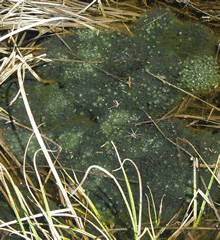Study Areas
|
Locations of primary mId-level monitoring
sites |
- The Inventory and Monitoring
Program of the National Park Service has provided additional
funding for our efforts in the latter two areas. We also have
conducted surveys in the Neal Smith National Wildlife Refuge,
the Mississippi National River and Recreation Area, other portions
of Minnesota, Iowa, Illinois, and Wisconsin.
Surveys
- We design our sampling to maximize the area over which we can
apply our results (area of inference), except when we look for
specific species in specific areas (targeted searches).
- One way we select sampling locations is to divide areas we intend
to sample into standard sized cells and then randomly select cells
to sample.
 |
Voyageurs National Park divided into
25-ha cells |
- We conduct surveys by listening for calls, visually
searching for animals, including using dip nets, and
by looking under cover-boards according to standardized
methods (Heyer et al. 1994). We also conduct targeted searches
and use minnow traps.
 |
 |
 |
Surveying calling amphibians |
Sampling using dip nets |
Checking cover boards |
- We measure several biological, physical, and chemical variables
during our surveys.
- Together these variables describe the numbers of individual
species we observe, their location, and the environmental conditions
at the time.
- During the course of our visual surveys, we evaluate animals
for obvious signs of ill health and deformities.

Egg masses of wood frogs
(Rana sylvatica)
with algae and fungus |
 Deformed northern leopard frog Deformed northern leopard frog
(Rana
pipiens) |
-
|
| Using
a PDA to record data in the field |
We record data in personal digital assistants (PDA) in the field and upload those data to computers
at the end of the day.
- Our principal method for evaluating the distributions of species
is by analyzing the percent of the area we sampled that was occupied
by each species (MacKenzie et al. 2002, 2003). All ARMI
regional scientists use the percent area occupied as their principal
statistic in describing data from mid-level monitoring.
Approval by the
Animal Care and Use Committee
- We have obtained the review and approval of our methods by a
USGS Animal Care and Use Committee.
Literature Cited
Heyer, W. R., M. A. Donnelly, R. W. McDiarmid,
L. C. Hayek, and M. S. Foster. 1994. Measuring and monitoring biological
diversity: standard methods for amphibians. Smithsonian Institution
Press, Washington, DC.
MacKenzie, D. I., J. D. Nichols, G. B. Lachman, S. Droege, J. A.
Royle, and C. A. Langtimm. 2002. Estimating site occupancy rates
when detection probabilities are less than one. Ecology 83(8):2248-2255
Mackenzie, D. I., J. D. Nichols, J. E. Hines, M. G. Knutson, and
A. B. Franklin. 2003. Estimating site occupancy, colonization, and
local extinction when a species is detected imperfectly. Ecology
84(8):2200-2207 |








 Deformed northern leopard frog
Deformed northern leopard frog